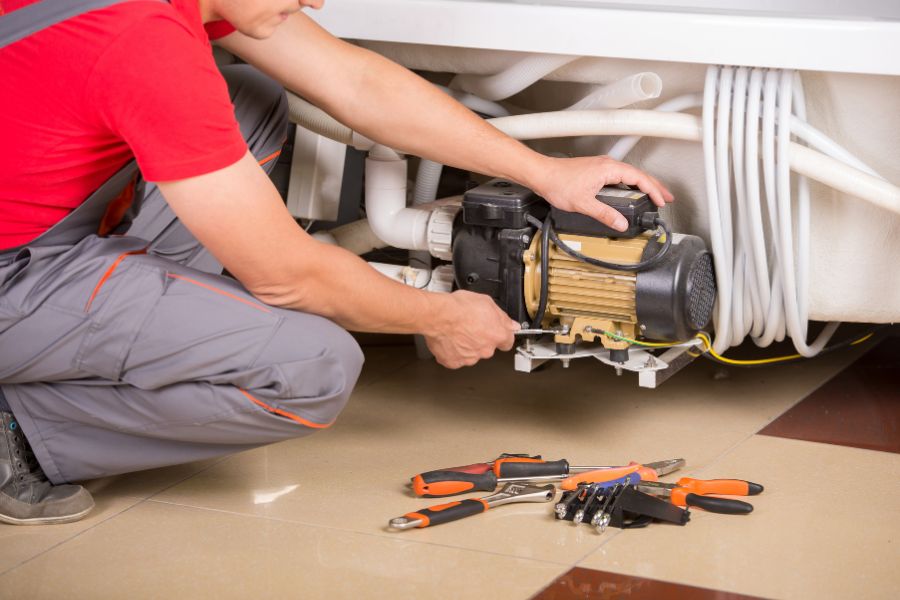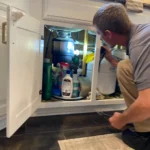A functioning water heater is one of those home essentials often taken for granted—until it stops working. Whether it’s a frigid shower or discolored water, a malfunctioning water heater disrupts daily routines and comfort. Fortunately, understanding how to repair a water heater doesn’t require advanced plumbing skills; it often comes down to recognizing common problems and applying simple solutions.
1. No Hot Water
When a water heater stops producing hot water, the problem often depends on whether you have a gas or electric unit. Let’s explore the typical causes and solutions for each type.
For Gas Water Heaters
- Pilot Light Failure:
The pilot light ignites the gas burner to heat the water. If the pilot light goes out, the water remains cold. To check if it’s out, look for a small flame through the inspection window. If it’s extinguished, follow these steps:- Relighting the Pilot: Turn the gas control knob to “Pilot” and hold down the button while you light the flame with a long lighter or match. Continue holding the button for 30-60 seconds to ensure the thermocouple heats up and keeps the flame lit.
- Replacing a Faulty Thermocouple: If the pilot light won’t stay lit, the thermocouple may be defective. This sensor detects whether the pilot is on and shuts off the gas if the flame goes out. Replacing the thermocouple is relatively straightforward and inexpensive.
- Gas Supply Issues:
If the pilot light is fine but there’s still no hot water, check your gas supply:- Gas Valve: Ensure the gas valve is fully open.
- Gas Pressure: Low gas pressure may prevent proper combustion. Contact your gas supplier if you suspect a pressure issue.
For Electric Water Heaters
- Faulty Heating Element:
Electric water heaters rely on heating elements to warm the water. If one of these elements fails, the heater won’t produce hot water. Here’s how to diagnose and fix it:- Testing the Element: Use a multimeter to check for continuity in the heating element. If it shows no continuity, the element needs replacement.
- Replacing the Element: Shut off the power, drain the tank, and unscrew the old element. Install a new one, ensuring a snug fit.
- Tripped Circuit Breaker:
A tripped breaker is a common cause of electric water heater failure. Check your electrical panel and reset the breaker if needed. If the breaker trips repeatedly, there may be a short circuit or a wiring issue.
2. Inadequate Hot Water
If you’re getting some hot water, but not enough to meet your needs, the issue could be minor or indicative of deeper problems. Here are the main culprits and their solutions:
- Incorrect Thermostat Setting:
Check the thermostat on your water heater. The ideal temperature range is 120°F to 140°F. If it’s set too low, increase the setting to meet your household’s hot water needs. - Sediment Buildup:
Over time, minerals like calcium and magnesium can accumulate at the bottom of the tank. This sediment acts as an insulating layer, reducing heating efficiency. Signs of sediment buildup include popping noises and lukewarm water.- Flushing the Tank: Drain the tank to remove sediment. Connect a garden hose to the drain valve, open the valve, and let the water flow until clear. Repeat this process annually to maintain efficiency.
- Damaged Dip Tube:
The dip tube directs incoming cold water to the bottom of the tank, where it can be heated. A cracked or broken dip tube allows cold water to mix with hot water at the top of the tank, leading to lukewarm output.- Replacing the Dip Tube: Remove the cold water inlet pipe, extract the damaged dip tube, and insert a new one. This is a relatively simple and low-cost repair.
3. Water Discoloration
Discolored water, whether brownish, rusty, or cloudy, is often a symptom of corrosion or sediment buildup. Ignoring this issue can lead to further damage and potential health concerns.
- Corroded Anode Rod:
The anode rod is a crucial component that attracts corrosive elements in the water, protecting the tank from rust. Over time, the rod deteriorates and needs replacement.- Inspecting and Replacing the Anode Rod: Turn off the power or gas, drain some water from the tank, and unscrew the anode rod from the top. If it’s heavily corroded, replace it with a new one. Consider using a magnesium anode rod for better protection.
- Tank Corrosion:
If the water heater tank itself is corroded, there’s no quick fix. Corrosion compromises the structural integrity of the tank, leading to leaks and potential failure.- Replacement: A corroded tank typically requires a full replacement. Consider upgrading to a stainless steel tank or a tankless water heater to minimize future issues.
- Flushing the Tank:
Regularly flushing the tank helps prevent sediment from causing discoloration. Aim to flush the system annually or semi-annually, depending on water hardness.
4. Strange Noises
Unusual sounds from your water heater can be alarming. Different noises indicate different problems. Let’s break down the most common sounds and their causes.
- Popping or Crackling:
- Sediment Buildup: As sediment accumulates at the bottom of the tank, water trapped beneath it creates steam pockets. When the pockets burst, they create a popping sound.
- Solution: Flush the tank to clear out sediment. If the buildup is severe, you may need to use a descaling solution.
- Humming or Vibrating:
- Loose Heating Elements: In electric water heaters, loose heating elements can vibrate during operation, causing a humming sound.
- Solution: Tighten the elements securely to eliminate the noise.
- Banging or Knocking:
- Water Hammer: This occurs when water flow is suddenly stopped or redirected, creating pressure surges that bang against the pipes.
- Solution: Install a water hammer arrestor or check valve to absorb the shock and reduce noise.
5. Leaking Water Heater
Leaks can cause extensive water damage if left unchecked. Identifying the source of the leak is crucial to finding an effective solution.
- Loose Connections:
Check the inlet and outlet pipes for moisture. Tighten any loose fittings with a wrench to stop the leak. - Pressure Relief Valve (PRV):
The PRV is designed to release pressure when it gets too high. If the valve is leaking, it may be due to excessive pressure or a faulty valve.- Solution: Test the valve by lifting the lever slightly. If water continues to leak, replace the valve.
- Cracked Tank:
If the tank itself is leaking due to corrosion or a crack, replacement is the only option. Continuing to use a leaking tank can lead to catastrophic failure.
6. Water Temperature Too Hot
Scalding hot water is a serious safety hazard, especially for children and the elderly. If your water heater produces excessively hot water, consider these possible causes:
- Thermostat Malfunction:
A faulty thermostat can cause the water heater to overheat. Test the thermostat by setting it to a lower temperature and observing the results.- Solution: If the water remains too hot, replace the thermostat.
- Faulty Heating Element:
A damaged heating element can stay on continuously, overheating the water. Use a multimeter to check for continuity. If the element is defective, replace it. - Safety Valve Issues:
The pressure relief valve helps maintain safe operating temperatures. If it’s malfunctioning, excessive pressure and heat can build up. Replace the valve if necessary.
Preventative Maintenance Tips
Preventative maintenance can significantly extend the lifespan of your water heater and improve efficiency. Here are essential maintenance tasks:
- Annual Flushing:
Flush the tank once a year to remove sediment and maintain efficiency. This is especially important in areas with hard water. - Inspect the Anode Rod:
Check the anode rod every 3-5 years and replace it when it’s more than 50% corroded. - Test the Pressure Relief Valve:
Lift the PRV lever and ensure it releases water. This test confirms the valve is functioning properly. - Check the Thermostat:
Keep the thermostat set between 120°F and 140°F for optimal performance and safety.
When to Call a Professional
While many water heater repairs can be handled with basic tools and knowledge, some issues require professional expertise:
- Gas Leaks: If you smell gas, leave the house immediately and call your gas company.
- Electrical Issues: Faulty wiring or persistent breaker trips may require an electrician.
- Major Leaks: If the tank is cracked or leaking significantly, a plumber can help with replacement.
Knowing how to repair a water heater can save you time, money, and frustration. From diagnosing a faulty pilot light to tackling sediment buildup, most issues are manageable with a little know-how and some elbow grease. Regular maintenance, such as flushing the tank and inspecting the anode rod, keeps your water heater running smoothly for years to come. When in doubt, don’t hesitate to call a professional to ensure safety and efficiency. Armed with this knowledge, you’ll be well-prepared to keep your household’s hot water flowing seamlessly.











